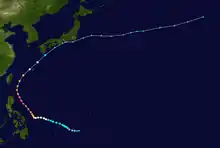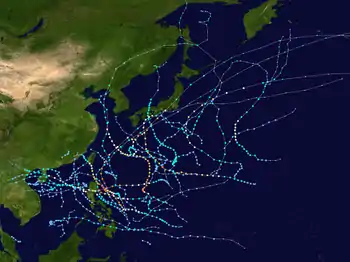Typhoon Songda (2011)
Typhoon Songda, known in the Philippines as Typhoon Chedeng, was a typhoon that impacted Japan in May 2011[1] and was the most intense tropical cyclone worldwide in 2011.
| Typhoon (JMA scale) | |
|---|---|
| Category 5 super typhoon (SSHWS) | |
 | |
| Formed | May 19, 2011 |
| Dissipated | May 29, 2011 |
| Highest winds | 10-minute sustained: 195 km/h (120 mph) 1-minute sustained: 260 km/h (160 mph) |
| Lowest pressure | 920 hPa (mbar); 27.17 inHg |
| Fatalities | 17 total |
| Damage | $287 million (2011 USD) |
| Areas affected | Micronesia, Philippines and Japan |
| Part of the 2011 Pacific typhoon season | |
Meteorological history

A weak non-tropical system formed within the Intertropical Convergence Zone on May 17, as it moved in a westward direction. On May 19, the JTWC reported that an area of low pressure had persisted about 510 km (320 mi) to the southeast of Yap. As the system moved towards the northwest under the influence of a subtropical ridge of high pressure, it rapidly consolidated in an area of light to moderate vertical wind shear. The JMA then started to monitor the system as a tropical depression later that day, before the JTWC designated it as Tropical Depression 04W early on May 20. The JTWC then reported later that day that the depression had intensified into a tropical storm with wind speeds of 65 km/h (40 mph), however, it later reported that it had overestimated the wind speeds and consequently lowered the storm's status to a tropical depression, based on observations from Yap island. Late on May 21, both the JMA and the JTWC reported that the depression had now become a tropical storm with the JMA naming it as Songda. Over the next couple of days, the system gradually intensified further while moving northwest into PAGASA's area of responsibility. PAGASA named it as Chedeng. At 12:00 UTC on May 24, the JTWC reported that Songda had intensified into a typhoon. 12 hours later, the JMA followed suit while the system was located about 800 km (500 mi) to the southeast of Manila in the Philippines. It rapidly intensified into a Category 5 typhoon. On the afternoon of May 29, Songda became extratropical south of Shikoku Island.[2] The extratropical remnants of Songda later crossed the International Date Line, which was later absorbed by another extratropical cyclone on June 4, and which later dissipated over Alaska.
Impact
Although Songda remained offshore, heavy rains within the typhoon's outer bands impacted the Philippines, causing significant flash flooding and landslides. Four fatalities are attributed to the system there.[3] Further north, Okinawa experienced intense wind gusts, measured up to 198 km/h (123 mph), along with torrential rain.[4] Extensive damage took place across the area with losses reaching ¥23.2 billion ($287 million);[5] however, there were no fatalities.[6] As it became extratropical, Songda brought heavy rains from Kyushu to eastern Honshu, causing significant flooding. At least 13 people were killed in the country and an estimated 400,000 had to be evacuated around Tokyo alone.[7][8]
References
- "Digital Typhoon: Typhoon 201102 (SONGDA)". agora.ex.nii.ac.jp. Retrieved 2020-08-19.
- Suga, Masumi (May 29, 2011). "Typhoon Songda Nearing Tokyo Weakens to 'Extratropical Cyclone'". Bloomberg. Retrieved August 16, 2012.
- "NDRRMC Update SitRep No. 15 on Typhoon "Chedeng" (Songda)" (PDF). National Disaster Risk Reduction and Management Council. National Disaster Coordinating Council. May 31, 2011. Archived from the original (PDF) on October 4, 2011. Retrieved August 4, 2011.
- Unattributed (May 28, 2011). 【台風1102号】沖縄:久米島灯台 風速55メートル (in Japanese). 吟遊詩人の戯言. Retrieved July 2, 2011.
- Unattributed (June 23, 2011). 保険支払い20億円に 台風2号 (in Japanese). Okinawa Times. Archived from the original on June 24, 2011. Retrieved July 2, 2011.
- Unattributed (May 29, 2011). "57 Injured in Okinawa, Tokyo Next". Accuweather. Star Tribune. Retrieved July 2, 2011.
- Unattributed (June 3, 2011). "Typhoon Songda Floods Strike Japan Disaster Zone". Earthweek. Retrieved July 5, 2011.
- Unattributed (May 30, 2011). 台風2号:県内で車水没、1人死亡 新居浜では避難勧告 /愛媛 – 毎日新聞 (in Japanese). おもっしょい愛媛. Archived from the original on April 25, 2012. Retrieved July 5, 2011.
